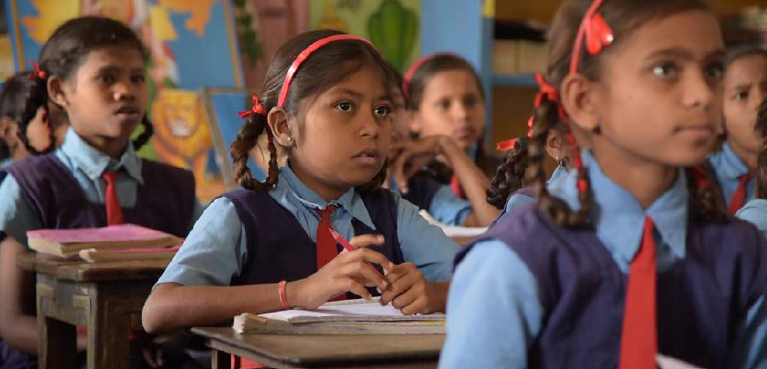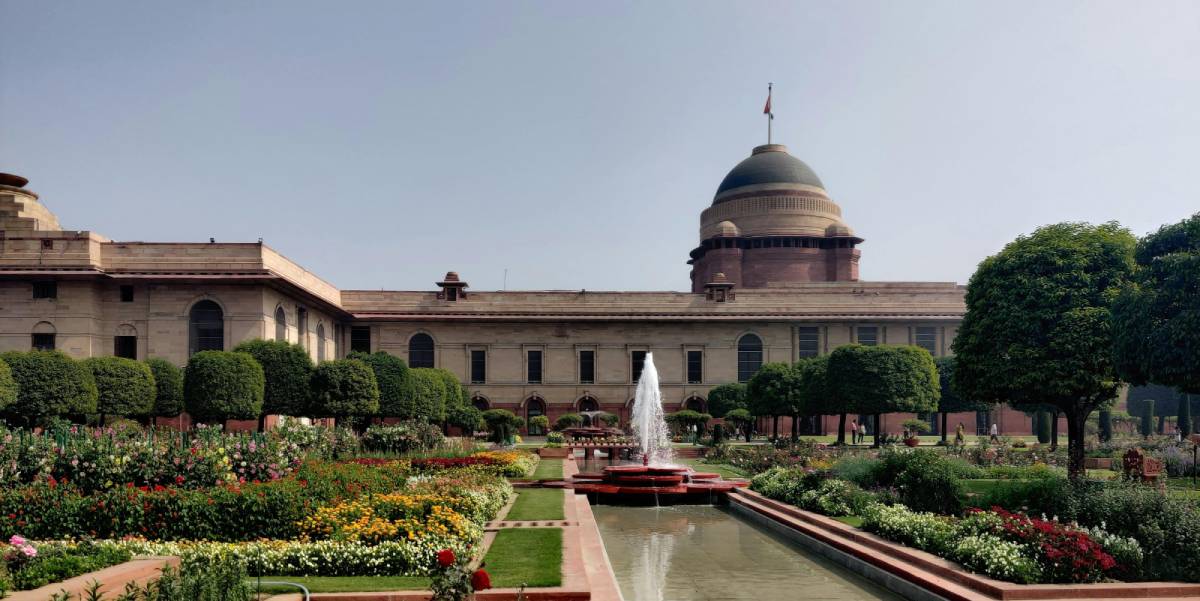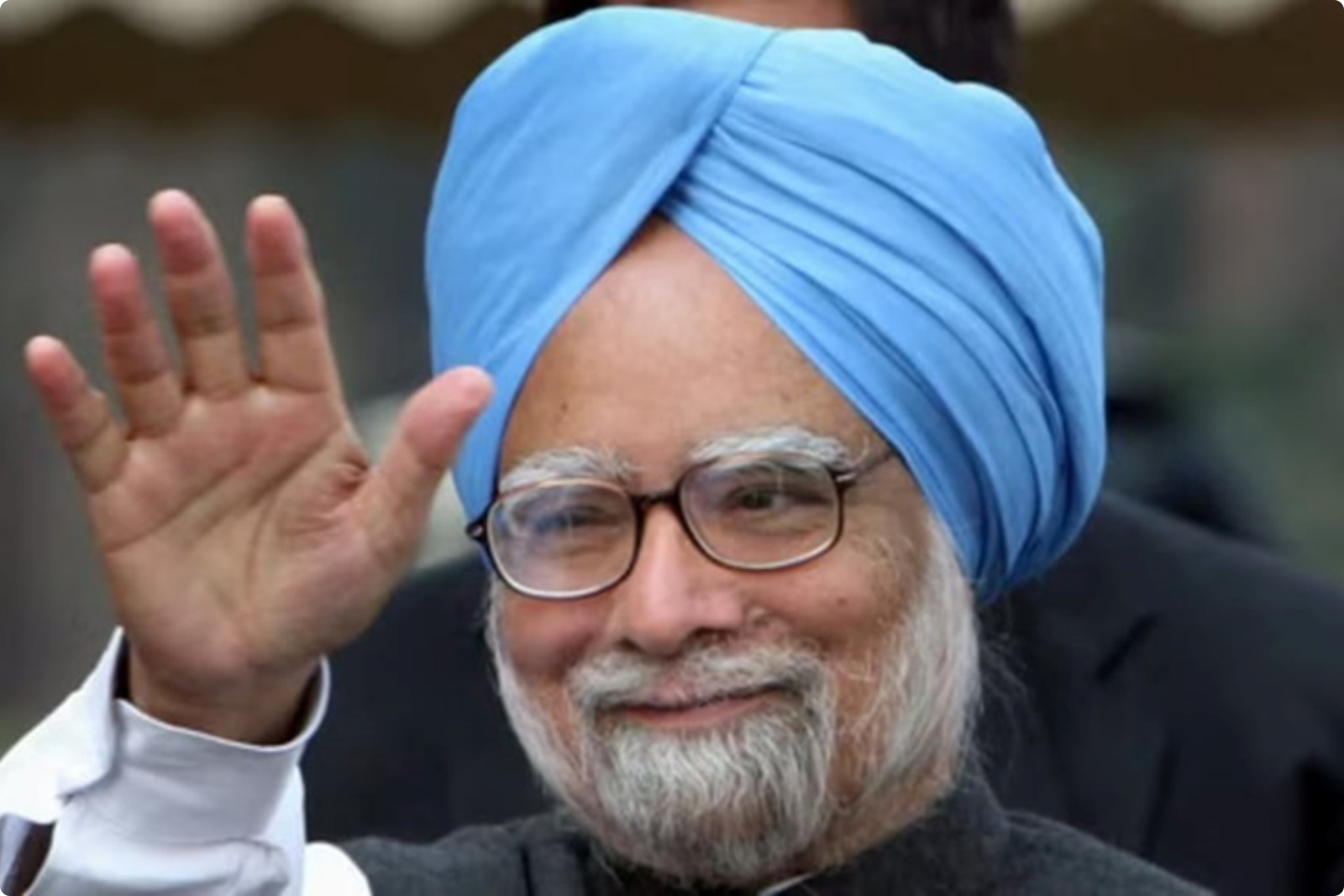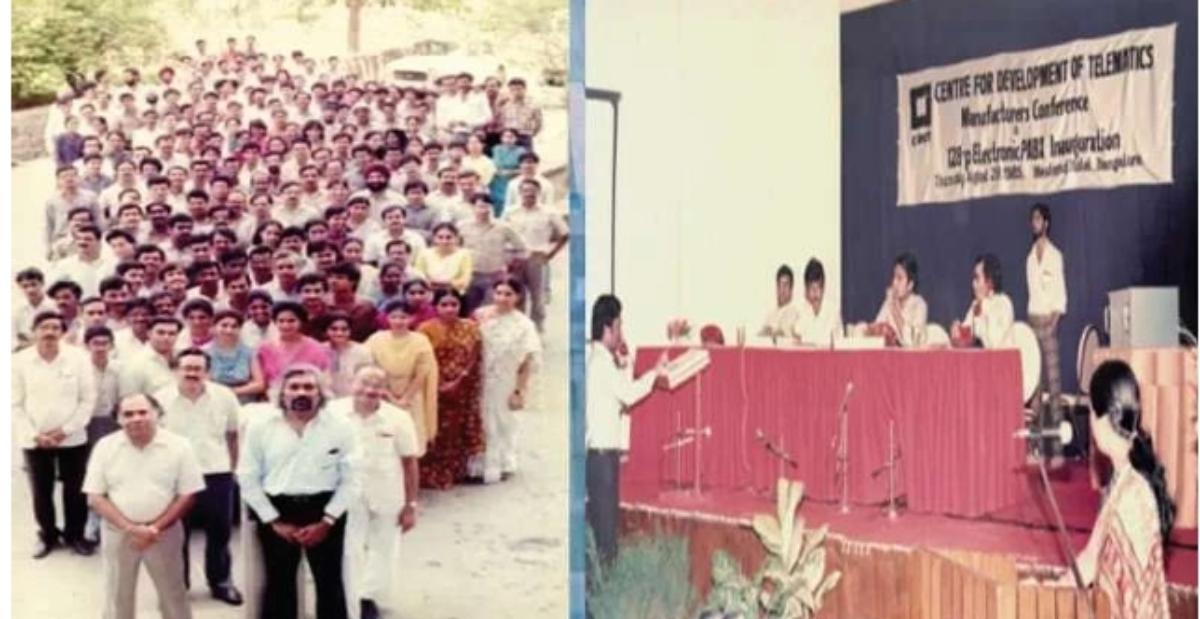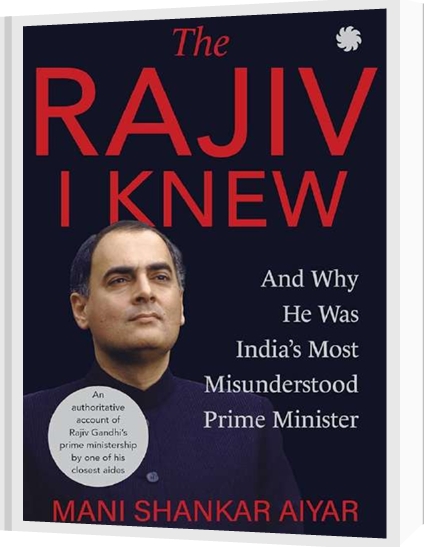Introduction
The Right of Children to free and Compulsory Education (RTE) Act, was enacted in the parliament of India on 4th August 2009, to fulfill the mandate of Article 21-A of the Constitution. The Act describes the modalities of providing free and compulsory education to all children between 6-14 years. It makes it legally binding on the state to ensure that all children within the age group are admitted to a formal school of a certain standard.
Many consider the RTE a historic step to undo past injustices. It carries with it the hopes and aspirations of millions who were previously excluded due to class, caste and patriarchy (RTE Forum 2018). However, even though the 10 year anniversary of this landmark Act has passed, its implementation still continues to be a huge challenge. According to a recent article in counterview, even after a decade only 12.7% of schools in India are RTE compliant. Considering the dismal state of compliance, this paper seeks to assess the performance of the RTE in order to identify some of the major bottlenecks, both, at the level of the Act, and at the level of implementation. It then aims to provide recommendations to address some of these challenges.
Performance and Bottlenecks
This paper seeks to assess the performance of the Act on the key elements on the demand side, supply side, as well as within governance and funding. The objective is to identify implementation bottlenecks.
Demand Side
(i) Student Enrolment
The RTE has helped increase the total enrolment in absolute terms especially at the upper primary level. The figure has increased by 23.86%, from 5,33,50,189 in 2008-09 to 6,54,48,222 in 2017-18 (DISE). However, there has been a steady decline since 2015. Table 1 shows the total enrolment at primary and upper primary levels since 2014-15. As per the data, in between 2014-15 and 2017-18 there has been a decrease in primary level enrolment by 6.22% and at upper primary level by 2.56%.
The enrolment based on different social groups is given in figure 1. As shown, the enrolment of STs and Muslims are particularly low. An important concern is the inclusion of children of migrant labourers and nomadic tribes (RTE Forum 2018).
Figure 1: Social Group wise Enrolment as a Percentage of Total Enrolment 2017-18
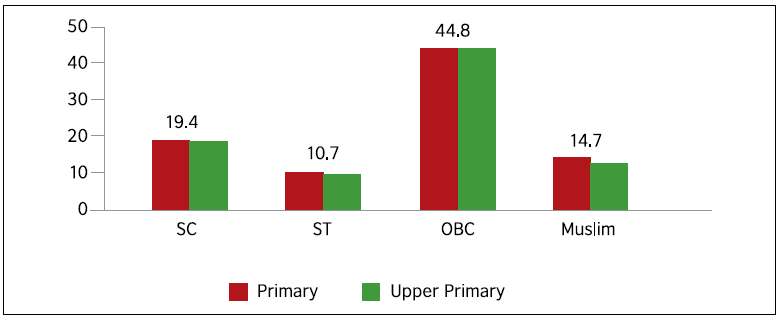
Source: DISE 2017-18
On the question of out of school children, there is lack of availability of updated data. Within the data that is available there are huge discrepancies as highlighted by the RTE Forum (op. cit.). There are contradictions in the data provide by the Census 2011 and MHRD (ibid). Even state level data suffers from variations. For instance, in Karnataka the PAB minutes note a decrease of 1 lakh children, however, as per the data provided by the state the fig. is 21,816 (ibid).
(ii) Student Drop Out and Transition Rates
In between 2016 and 2017 the total drop-out rate at primary level had gone up from 4.13 to 6.35 and at the upper primary level from 4.03 to 5.76 (DISE). As per the latest DISE data shown in figure 2, in 2017-18 it came down to 3.51 and 5.02, respectively. In spite of the slight decline, the overall drop out continues to remain high. The figures also point to a gender divide. The drop out for girls at the upper primary level which is at 5.57 is much higher than boys, which stands at 4.49. This is a matter of concern and needs a gendered focus. There are also large variations in dropouts within the states. As per the data, the dropouts are the highest for Bihar (13.29) at the upper primary level and for Assam (10.08) at the primary level. The figures are particularly high for the north east states.
Figure 2: Average Annual Drop-Out Rates for Different Social Groups 2017-18
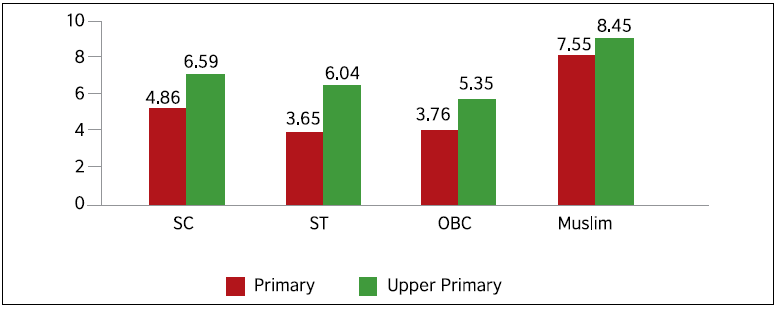
Source: DISE 2017-18
The drop-out rates for different social groups is given in figure 3. As shown, the figures for Muslims are the highest at both levels. Over one year the drop-out rate for STs has fallen from 8.54 to 3.65 at primary level and from 9.58 to 6.04 at upper primary level, which is a positive sign.
The transition rates from upper primary to secondary are much lower than from primary to upper primary, except for boys where it is higher. For girls (91.1) the rate is higher than boys (90.47) for primary to upper primary. However, there is a reduction at the higher level, where it drops to 87.54 as compared to 90.84 for boys. In the context of marginalized social groups the rate for muslims is the lowest at both levels of transition which suggests a concern in retaining muslim children. For STs the figure for 2016-17 (DISE) was 86.65 at the lower level and 83.29 at upper primary to secondary. Thus, there has been an improvement in the transition rate for STs particularly from primary to upper primary.
Figure 3: Transition Rate as a Percentage of Total Enrolment 2017-18
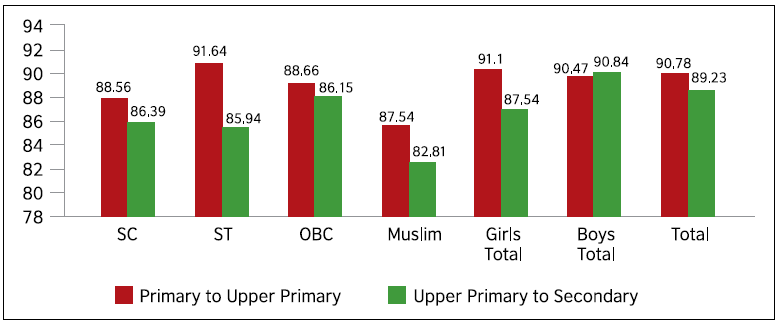
Source: DISE 2017-18
(iii) Student Learning Outcomes
The learning outcomes of students are highlighted in table 1. The data is taken from the ASER (2018) report. As shown, the percentage of children in class 3 who can read class 2 level texts has increased from 25.1% in 2016 to 27.2% in 2018. At class 5 the proportion has increased from 47.9% to 50. 3% and at class 8 level the figure has remained constant at 73% between 2016 and 2018. Amongst the states, for students enrolled in government schools, Punjab, UP, Mizoram and Kerala have shown the most improvement (more than 5%) in reading skills across levels.
Table 1: Learning Outcomes at Primary Level

Source: ASER 2018
In basic arithmetic skills, the students of class 3 who could do basic subtraction has increased marginally from 27.6% to 28.1%, and class 5 students who could do basic division has increased from 26% to 27.8% during the period. While, the figures do reveal a slight improvement, they continue to indicate very poor learning outcomes across levels. This is one of the most important concerns as attending school becomes meaningless if appropriate learning is not happening.
Supply Side
(i) School Compliance with RTE Infrastructure Norms
While most numbers are above 95% and remain consistent with the previous year, the figures for boundary wall, playground, kitchen shed and ramp remain low. However, it is important to note the since the DISE data is self reported by schools the accuracy remains questionable. The CAG (2017) has noticed many inconsistencies in the DISE figures.
(ii) Availability of Trained Teachers
The RTE at the time of implementation allowed 3 years for the recruitment of teachers and 5 years to complete their training. However, the current data highlights a continual shortage under SSA. As per the Lok Sabha Question 2018 (as cited in RTE forum 2018), while the recruitment of 19,33,398 teachers were sanctioned, there is a vacancy of 4,17,057 teachers, which is more than 21%. A large number of para teachers continue to be hired.
The RTE norms prohibit single teacher schools, but as per the DISE data, in 2018 there were still 6.74% schools with single teachers. The PTR at primary level stood at 23 (DISE 2017-18) which is lower than the stipulated 30 and meets the RTE norm. The RTE prohibits the use of teachers for activities other than teaching. A 2008 SC order also prohibits using teachers for non academic duties, however, this practice continues. Another important concern is the lack of grievance redressal options for teachers (RTE Forum 2018).
(iii) 25% Reservation in Private Unaided Schools
Section 12(1)(c) allows for 25% reservation for economically weaker sections (EWS) and disadvantaged groups (DG) in private unaided schools. It has been estimated that around 16 million children should be getting admission under this provision (RTE Forum 2018). However, due to resistance and many implementation hurdles, enrolment remains below the stipulated figure. There are also huge variations across states. A 2017 paper (Sarin, Dongre and Wad 2017) observed that the enrolment rate in 2013 -14 in UP was only 3.62 percent and in AP it was an appalling 0.21 percent of the total stipulated seats under this provision, as compared to MP which had 88.2% filled seats.
Governance and Financing
(i) Convergence of Schemes
In May 2018 the government launched the Samagra Shiksha programme leading to the convergence of SSA, RMSA and Teacher Education. The rationale was to achieve administrative efficiency by streamlining resource allocation and spending. The unified scheme is supposed to optimize the utilization of both human and physical resources. The goal is also to align elementary and secondary education and give flexibility to states to prioritise either, depending on needs. However, as per a study conducted by CPR in 5 states, at ground level there is lack of clarity. The convergence of finances, administrative structures and monitoring mechanisms remains incomplete. Before this convergence, annual financial plans at each level were prepared separately for elementary and 28 secondary education. There is a question mark on how collaborative planning under Samagra will be achieved. There is also concern that if in some year secondary education is prioritized this may reduce allocation for elementary education.
(ii) School Consolidation
In order to optimize utilization of resources a new policy tool that is increasingly being used across certain states is the consolidation of schools into one unit. The process involves closure of number of schools and transferring all resources into one integrated school. It was institutionalized in Rajasthan since 2014-15 as part of its “Adarsh Schools” programme, where it was envisioned to develop one such model school in each of its 9895 Gram Panchayats over a period of time (RTE Forum 2018). These model schools were expected to have all the necessary facilities to ensure improved learning. As per the department of education in Rajasthan in between 2014 and 2019 around 22000 schools have been merged (Bordoloi 2019).
The rationale behind school closures, as per the education department in Rajasthan were twofold: (1) Inadequate enrolment in some schools and/or, (2) the existence of more than one primary or upper-primary school within the same revenue village (ibid). However, a study in Rajasthan by CPR (ibid) has found that post consolidation there has been a greater decline in enrolment in these schools (7% in 2014-15) than the decline in all government schools (1.4% in 2014-15) in the state. Further, the study also found that decline in enrolment was the highest amongst CWSN followed by SCs and STs. School consolidation also violates the RTE norm of having primary schools within 1 km from residence.
(iii) Emerging Trend of Privatization
There has been a growing narrative on the poor performance of government schools which has led to a push towards privatization. The NITI Aayog, in its 3 year Action Agenda in August 2017, recommended setting up of expert groups to explore policy options such as vouchers and outsourcing of school services to private players (NITI Aayog 2017). It argued that handing over “non performing” government schools to private entities under the PPP model may help improve performance (ibid). In 2017, the Rajasthan government had pushed the policy for “Public Private Partnership in School Education”. The objective was to privatise 300 government schools which have recorded poor results. However, due to massive protests by the teachers and other community members the government had to eventually roll back the policy.
(iv) Administrative Issues
As per the Act the local authorities have several functions which include ensuring availability of schools within neighbourhood limit, preventing discrimination against marginalized communities, maintaining records of children, monitoring admission and attendance, ensuring availability of infrastructure, teaching staff and learning material, making teacher training available, monitoring of school functions, ensuring timely prescribing of curriculum, as well as deciding academic calendar. The extent of roles and responsibilities as well as constant shortage of staff and financial resources has led to huge inefficiencies in administration. There needs to be better linkages between them to enable efficient governance.
(v) Spending on Education
One of the most important factors in implementing the RTE lies in its financing. Since education is in the concurrent list, section 7(1) of the Act states that both the Centre and the States will have the responsibility of providing funds for its implementation. Over the years activists having been arguing that spending on education is well below what is required. The Kothari Commission in 1964 had recommended spending at least 6% of GNP on education by 1985-86. Further, it also advised allocating two-thirds of total education spending on school education. However, the current data suggests that spending continues to be below par.
Figure 4: Spending on Education as a Percentage of GDP
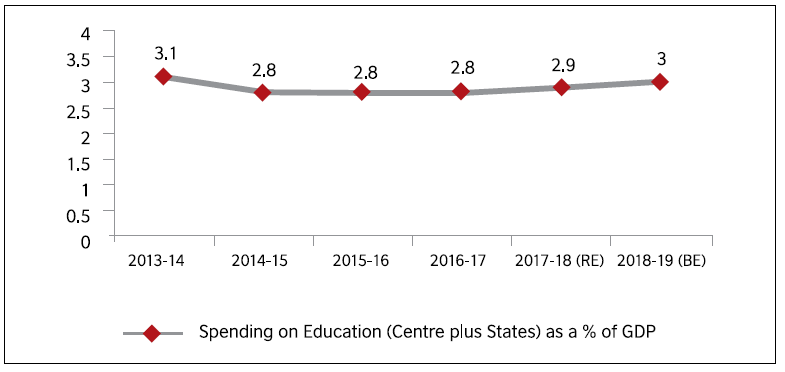
Source: Economic Survey Volume 2, 2018-19
The allocation for SSA, which is the primary instrument of RTE implementation, is depicted in figure 5. As shown, after 2014-15 (28,258 crores), there was a major dip to 22,000 crores (2015-16). Since then there has been a marginal increase over the years, however, as per the 2018-19 budgetary estimates, the figure still stands below 2014-15 numbers at 26,129 crores. This decline is even steeper if inflation is taken into account.
As per 2017-18 budgetary estimates, the figure approved was 55,000 crore but the actual allocation was 26,129 crores, which is 42.7% of the approved amount (CBGA 2017). It is also a matter of grave concern that since 2013-14 there has been a severe and consistent drop in the allocation percentage, which has declined from 87.9% in 2013-14 to 42.7% in 2017-18.
Figure 5: GOI Allocations for SSA
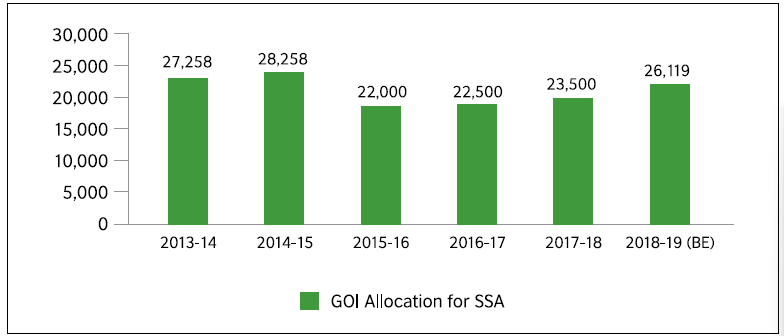
Source: RTE Forum 2018
Another issue with the financing of SSA is that the biggest proportion is coming from the education cess. While the initial purpose of the cess was to supplement the government funding, over the years it has almost replaced government expenditure.
Figure 6: Education Cess % of Total SSA Funding
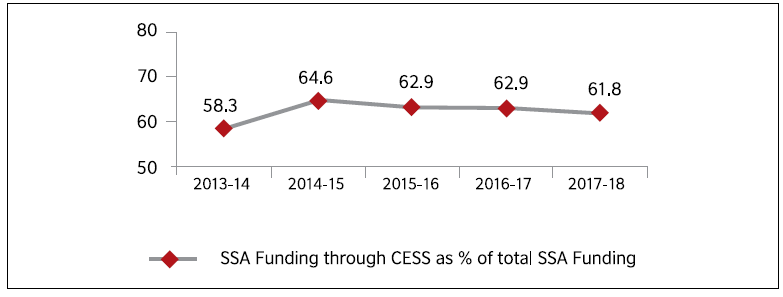
Source: CBGA 2017
Addressing the Bottlenecks
1.Recommendations for the Government
- Addressing Problems in the Act
- Extend the scope of RTE to 3-18 years
- Include a clear definition on which institutions can be considered a minority
- Institution for the purpose of the Act
- Train teachers to effectively implement CCE. Have a clear road map to bring back
- No detention up to 8th standard, once CCE is properly implemented
- Align the RTE to the RPWD Act 2016 from the earlier 1996 law
2. Addressing Demand Side Problems
- Mapping of out of school children needs to be done to have up to date data and to understand reasons for non enrolment
- Take measures to track attendance of students through a database, and not just enrolment. Attendance database can help identifying risk of drop out
- iii. Change the Child Labour Act to prevent employment of children even in family run businesses. Also need awareness campaigns targeted to ensure parents don’t put children to work and instead send them to school
- Special focus to bring back and retain children from disadvantaged communities especially STs, Muslims, migrant labour and nomadic tribes. Need targeted awareness campaigns and if possible incentives (such as conditional cash transfer like Brazil). Try to provide residential schools for children of migrant labour and nomadic communities
- Ensure constant dialogue with representatives of minority institutions to get them under the purview of RTE in the long run
- Need special focus on children from the North East similar to disadvantaged communities
- Girls drop-out rate increases at upper primary level. One possible reason could be that once girls reach puberty, social taboo around menstruation and a lack of menstrual hygiene facilities in school may cause them to drop out. Need to include menstrual hygiene facilities in all schools with female students and having secondary grades. Ensure friendly and supportive environment for girls.
Addressing Supply Side Problems
- Ensure proper implementation of CCE with a focus on foundational skills. Regular oral assessments for lower grades which focus on basic skills and regular interventions to address weaknesses. Realign curriculum to stress on foundational skills
- Learning outcomes should go beyond standardized tests. The focus of learning should be on understanding. Tests can mostly assess what children know, understanding needs to be assessed by teachers on a continual basis. The overall purpose of education should be intellectual growth of the child and not simply attaining marks in tests
- Medium of instruction in the lower grades as far as possible should only be in the mother tongue. English should be introduced gradually in later grades
- Ensure school availability within mandated 1km
- Ensure availability of all facilities as per RTE norms including safety regulations to ensure child friendly and safe learning environment. Special attention needs to be given to inclusive infrastructure for CWSN as per RPWD 2016 provisions
- Need independent audit of DISE data
- Teacher vacancies need to be filled as soon as possible. Hiring teachers for CWSN also needs attention
- Teacher training needs to be fast tracked. Training should include understanding of CCE as well as sensitization about gender and social inclusion. Need strengthening and adequate funding of teacher training institutions
- Provide autonomy to teachers on teaching activities to enable them to cater to specific needs of children. Non academic duties should be completely stopped
- Ensure compliance with 12(1)(c) to enable social integration of rich and poor children. Need regulatory mechanism for private schools
- Application forms for 12(1)(c) needs to be simplified and standardized. Ensure adequate help desks to support filling both offline and online forms
- Strict Action against schools charging non tuition fees from children admitted under 12(1)(c)
- Mechanism for arriving at per child cost needs to be standardized. Reimbursements should happen on a timely basis
Addressing Problems in Monitoring and Grievance Redressal
- SMCs in all mandated schools should be constituted on an immediate basis
- Election process of SMCs needs to have clear guidelines and should be made transparent. Encourage parents from disadvantaged communities to participate in elections and ensure they are empowered through proper training
- Increase awareness amongst parents about roles and functions of SMCs and its election process through PTA meetings. Information transparency boards as mandated by SSA, also need to be operationalized within schools to disseminate information about schools such as mid day meals, student teacher attendance etc., as well as information about roles and responsibilities of SMCs
- Ensure adequate funding and training of SMCs to enable them to handle SDPs and other financial and administrative activities. Training funds should be tracked to ensure proper and timely utilization. Training should be interactive and timely and include easy to use handbooks. Strengthen SMC linkages with community and Gram Panchayat as well as ensure platforms for encouraging peer learning between SMCs.
- Ensure timely allocation of school grants to enable SMCs to make SDPs in a timely manner. Since SDPs form the basis of decentralized budgetary planning this needs to be a priority
- Ensure monitoring of teacher attendance and teaching practices by SMC. Over a period of time give more responsibilities to SMCs such as monitoring not just inputs, but also academic aspects
- Increase awareness about grievance redressal within communities by engaging CBOs, and in schools through SMCs and PTA meetings. Encourage filing of RTIs by parents to ensure transparency within schools and local authorities
- Form linkages between local authorities and communities to connect local authorities with ground level issues. Ensure role clarity and clear line of ownership of local authorities on grievance redressal. Ensure availability of adequate staff and resources. Increase awareness of local authorities on grievance redressal through proper training
- Provide a complaint tracking system with fixed timelines to enable resolving complaints in a timely manner.
- Ensure sufficient child helplines are made available.
- Provide grievance redressal mechanism for teachers
- In the short term strengthen capacity and ensure adequate staff and funding within NCPCR/SCPCR for timely redressal. Since NCPCR is already burdened with other functions, in the long term there needs to be a separate tribunal system for school
- education with adequate enforcement powers.
Addressing Problems in Governance and Financing
- Provide clarity of administrative and financial functions within Samagra Shiksha post convergence
- Ensure convergence does not lead to lack of focus on SSA which is the primary vehicle for RTE. Ensure separate and adequate funds are available for SSA, RMSA and Teacher Education
- School closure and consolidation needs to stop as it increases dropouts and is in violation of RTE norm of neighbourhood schools within 1km
- Privatization will lead to exclusion of children from disadvantaged communities and needs to be avoided. It needs to be recognized that education is a public good and the responsibility of the government
- Local Authorities have too many roles. Community and PRI participation should be encouraged to undertake some of these activities such as mapping of out of school children, mapping of requirements for neighbourhood schools etc. Enable delegation of roles and clear line of ownership within local authorities. Provide adequate staff and funding
- Ensure proper linkages between different departments and ministries involved with education to streamline administration
- Education funding needs to be increased incrementally, with a clear road map with specific timelines of reaching 6% GDP on overall education, and 4% of GDP on school education
- Ensure adequate funds to SSA as approved by MHRD. In 2013-14 allocation had reached 88% of approved amount, but has gone down since and is a serious concern. It needs to be recognized that MHRD approvals are based on AWP&B which forms the basis of decentralized planning. There should be a clear road map of reaching allocation of 100% of the approved amount, and it should be achieved as soon as possible
- Education cess should supplement budgetary allocations. In the short term cess could continue to be used for SSA, however, there needs to be a clear road map with proper time lines to ensure SSA in the long run is funded through budgetary allocation, with cess only providing additional support
- SSA allocations need to be tracked with regular reviews to ensure proper and timely utilization of funds
Conclusion
The RTE is one of the most progressive legislations making primary education a legally enforceable right, yet its implementation continues to have many challenges. Even after 10 years many children continue to be out of school, most schools continue to lack basic facilities and many teacher vacancies remain. All these concerns are fundamentally related to the huge resource gap at each level. Education has rightly been recognized as a very important priority by the government (Budget Speech 2016), however, financing of education remains well below par.
Allocations are nowhere near 6% of GDP as recommended by the Kothari Commission and the funding for SSA remains well below the MHRD requirements. Even within the allocations a major chunk is coming from the education cess. Today there is an urgent need for the government to move beyond rhetoric and take concrete steps to showcase its commitment to education. Once adequate resources are provided most ground level concerns can be addressed, and only then can the right to education truly be realized.
References
ASER. 2018. Annual Status of Education Report (Rural) 2018. New Delhi.: ASER Centre.
Bordoloi, Mridusmita and Shukla, Ritwik. August 2019. School Consolidation in Rajasthan: Implementation and Short Term Effects. New Delhi.: Accountability Initiative, Centre for Policy Research.
CAG. 2017. Report of the CAG on Implementation of RTE Act, 2009: Report No. 23 of 2017. New Delhi.: Ministry of Human Resource Development, Government of India.
Government of India. 2009. Right of children to free and compulsory Education Act.
Government of India. 2009. Model Rules under the Right of children to free and compulsory Education Act
JOSH. 2014. Status of Implementation of the Right of Children to Free and Compulsory Education Act, 2009: The Delhi Story 2012-13. New Delhi.
Joshi, Natasha. April 2019. ‘No-Detention: Why did a popular policy get scrapped,’ India Development Review, Online.: India Development Review.
Juneja, Nalini. January 2018. ‘Constitutional History of Right to Education and Legislation in India,’ Norrag, Special Issue 1. Geneva.: Norrag, pp. 37-39.
Kapur, Avani, Bordoloi, Mridusmita, and Ritwik Shukla. 2019. Sarva Shiksha Abhiyan (SSA), GoI, 2018- 19: Budget Briefs, Vol 10, Issue 1. New Delhi.: Accountability Initiative, Centre for Policy Reasearch.
Kundu, Protiva. 2017. Is There Enough Public Resource for School Education? Examining the Available Evidences. New Delhi.: Centre for Budget and Governance Accountability.
Lee, Sharon E. 2013. ‘Education as a Human Right in the 21st Century, ‘Democracy and Education, Vol. 21, No. 1. Online.: Democracy and Education, pp. 1-9.
MHRD. 2019. Draft National Education Policy. New Delhi.: Ministry of Human Resource Development, Government of India.
MoF. 2019. Economic Survey 2018-19 Vol 2. New Delhi.: Ministry of Finance, Government of India.
Mukherji, Anahita. June 7, 2012. ‘25% RTE quota: Getting the poor into private schools,’ ET Bureau. Mumbai.: Economic Times.
Niti Aayog. 2017. Three Year Action Agenda: 2017-18 to 2019-20. New Delhi.: Niti Aayog, Government of India.
Oxfam. November 2015. Grievance Redress and Right to Information Act: Seeking Accountability for Effective Implementation of RTE Act: Learning from the Field. ES-Education, No. 3. New Delhi. Oxfam
in Action PRS. April 2012. Supreme Court upholds 25% reservation in private schools, New Delhi.: PRS Legislative Research.
—-. September 2017. “Rethinking the No Detention Policy”, New Delhi.: PRS Legislative Research.
—-. 2019. “Demands for Grants 2019-20 Analysis: Human Resource Development”, New Delhi.: PRS Legislative Research.
RTE Forum. March 2018. Status of Implementation of The Right of Children to Free and Compulsory Education Act, 2009. New Delhi.: Right to Education Forum.
Sarin, Ankur, Ambrish Dongre, and Shrikant Wad. 2017. State of the Nation: RTE Section 12(1)(c). IIM Ahmedabad.
Sengupta, Meeta. April 22, 2017. ‘It’s time to reform the RTE Act,’ Live Mint. New Delhi: Live Mint.
Sever, M. 2012. ‘A critical look at the theories of sociology of education,’ International Journal of Human Sciences, Vol. 9, No. 1. Online.: International Journal of Human Sciences, pp. 650-671.
U-DISE. 2018. School education in India, 2017-18, Flash Statistics. New Delhi.: National University of Educational Planning and Administration.

